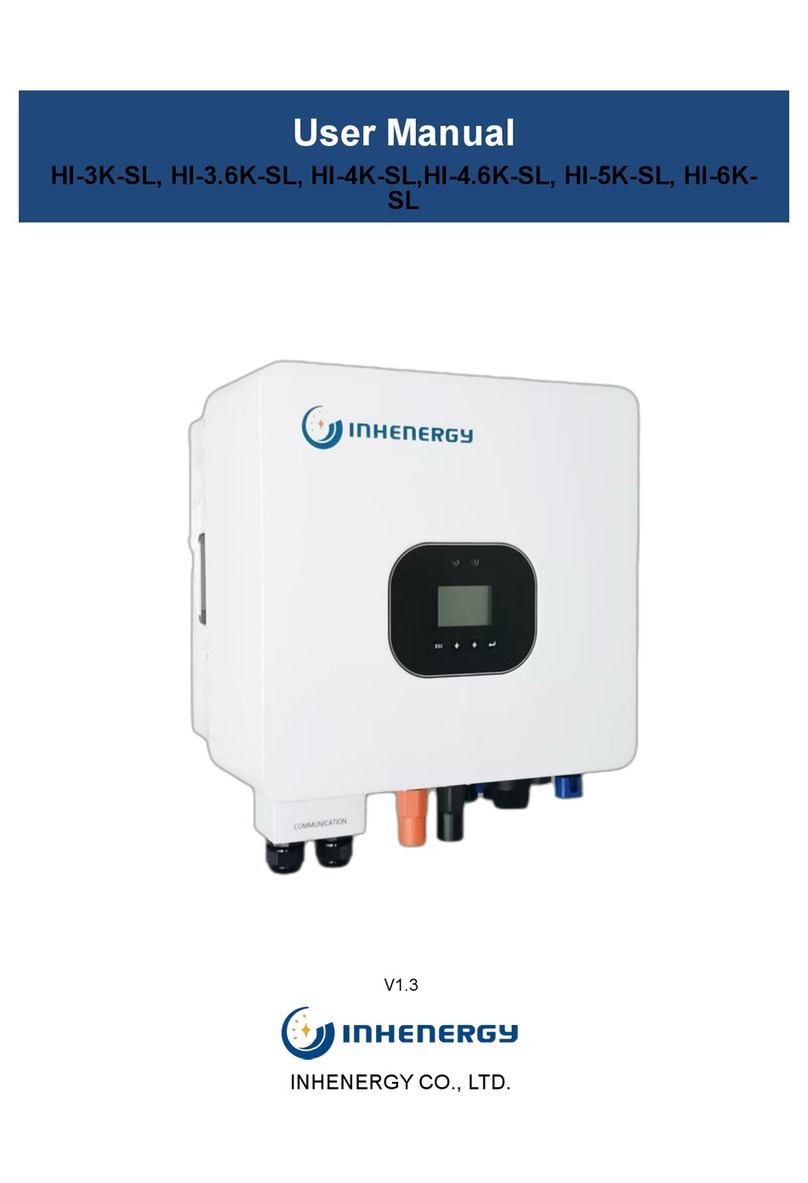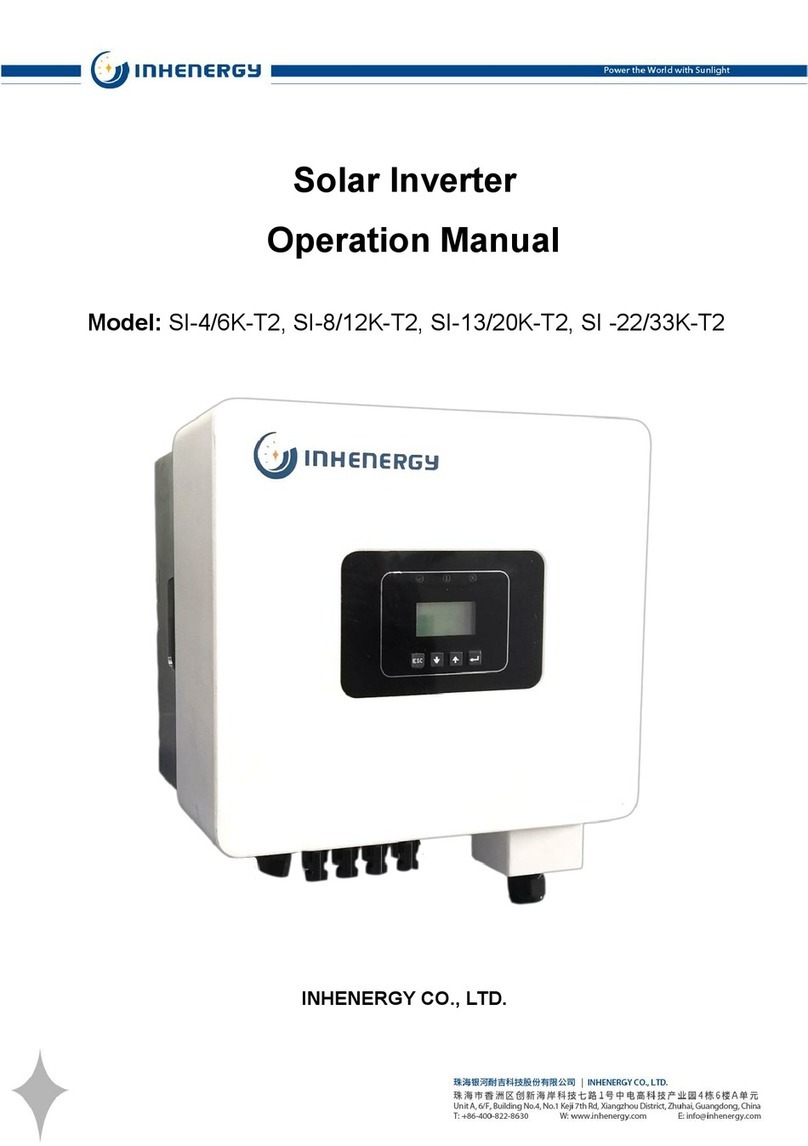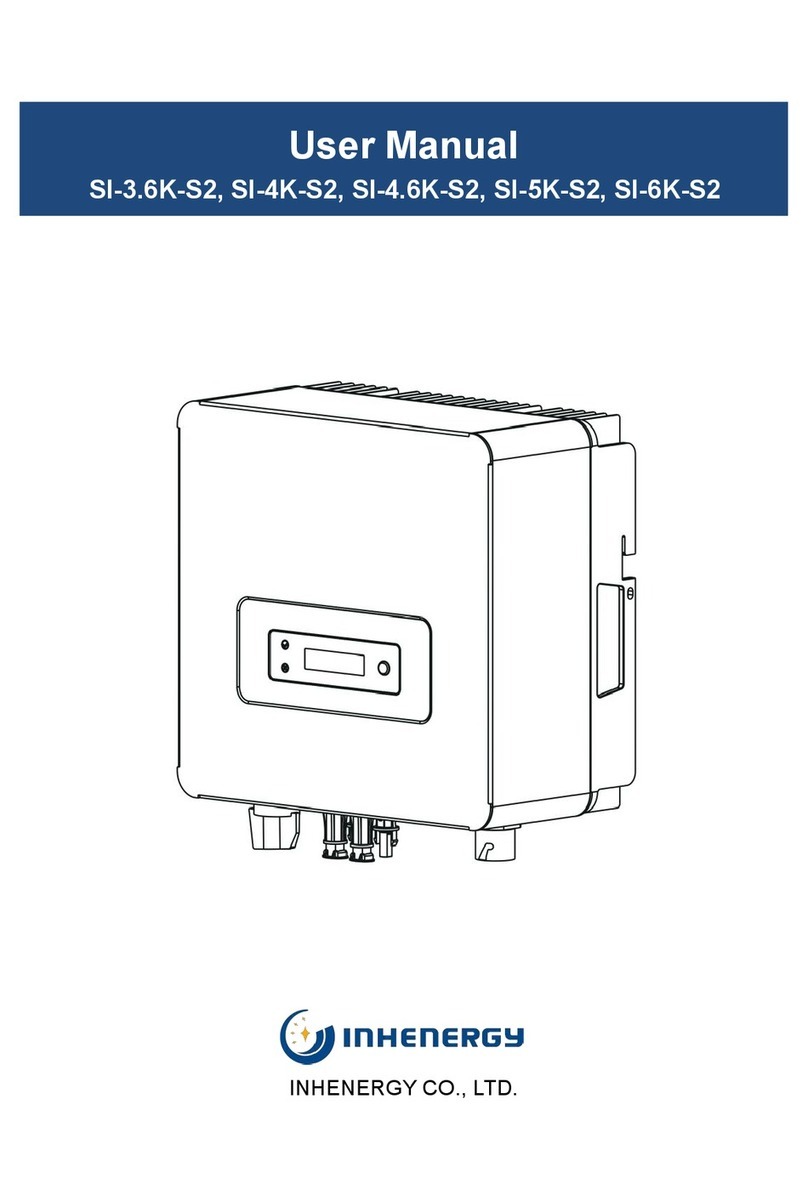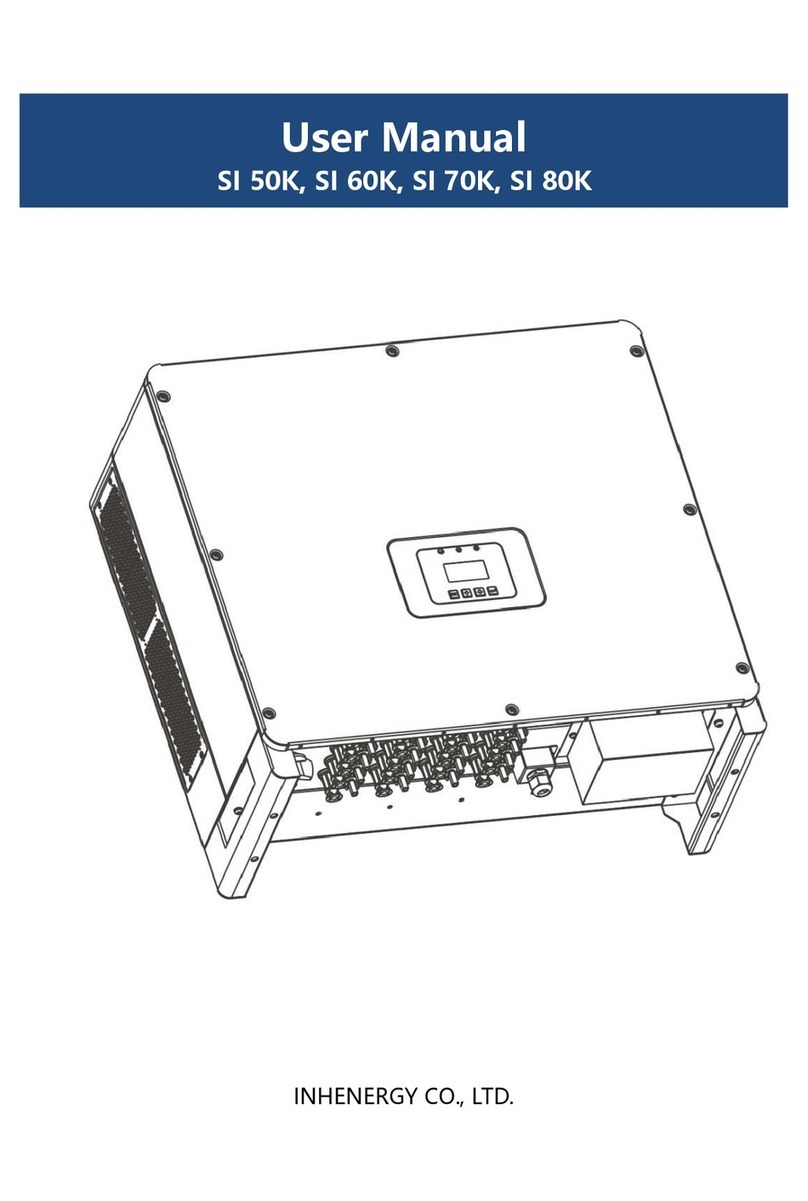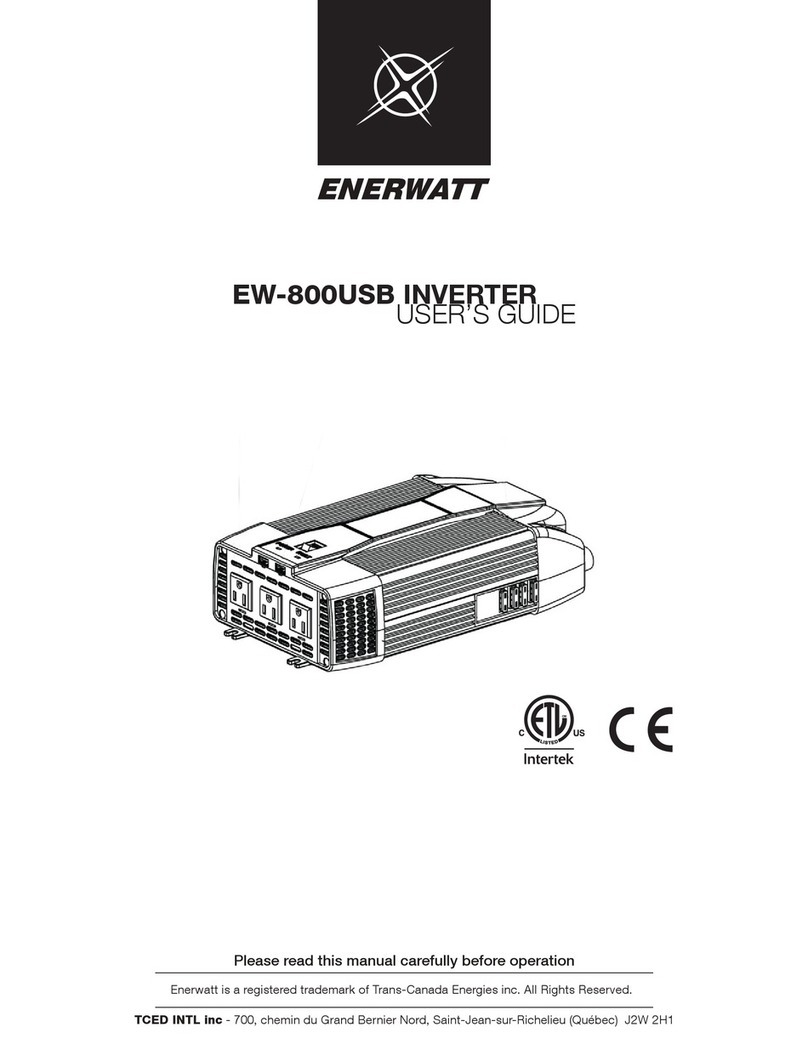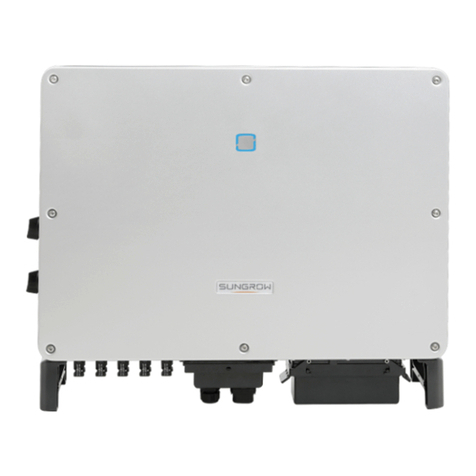INHENERGY NI-5048M-HF User manual

NI-5048M-HF
SOLAR INVERTER
Version: 1.1
User Manual

Table Of Contents
ABOUT THIS MANUAL ...................................................................................................................................... 1
Purpose............................................................................................................................................................ 1
Scope............................................................................................................................................................... 1
SAFETY INSTRUCTIONS................................................................................................................................... 1
INTRODUCTION ................................................................................................................................................. 2
Features........................................................................................................................................................... 2
Basic System Architecture ............................................................................................................................... 2
Product Overview............................................................................................................................................. 3
INSTALLATION ................................................................................................................................................... 4
Unpacking and Inspection................................................................................................................................ 4
Preparation ...................................................................................................................................................... 4
Mounting the Unit............................................................................................................................................. 4
Battery Connection .......................................................................................................................................... 5
AC Input/Output Connection............................................................................................................................ 7
PV Connection ................................................................................................................................................. 8
Final Assembly................................................................................................................................................. 9
Remote Display Panel Installation ................................................................................................................. 10
Communication Options................................................................................................................................. 11
Dry Contact Signal ......................................................................................................................................... 12
BMS Communication ..................................................................................................................................... 12
OPERATION......................................................................................................................................................13
Power ON/OFF .............................................................................................................................................. 13
Operation and Display Panel ......................................................................................................................... 13
LCD Display Icons ......................................................................................................................................... 14
LCD Setting.................................................................................................................................................... 16
Display Setting ............................................................................................................................................... 26
Operating Mode Description .......................................................................................................................... 31
Battery Equalization Description .................................................................................................................... 33
Fault Reference Code.................................................................................................................................... 35
Warning Indicator ........................................................................................................................................... 36
SPECIFICATIONS ............................................................................................................................................. 37
Table 1 Line Mode Specifications ................................................................................................................... 37
Table 2 Inverter Mode Specifications ............................................................................................................. 38
Table 3 Charge Mode Specifications .............................................................................................................. 39
Table 4 General Specifications ....................................................................................................................... 39
TROUBLE SHOOTING .....................................................................................................................................40
Appendix A: The Wi-Fi Operation Guide in Remote Panel ..........................................................................48

1
ABOUT THIS MANUAL
Purpose
This manual describes the assembly, installation, operation and troubleshooting of this unit. Please read
this manual carefully before installations and operations. Keep this manual for future reference.
Scope
This manual provides safety and installation guidelines as well as information on tools and wiring.
SAFETY INSTRUCTIONS
WARNING: All safety instructions in this document must be read, understood and
followed. Failure to follow these instructions will result in death or serious injury.
1. Before using the unit, read all instructions and cautionary markings on the unit, the batteries and all
appropriate sections of this manual.
2. CAUTION --To reduce risk of injury, charge only deep-cycle lead acid type rechargeable batteries.
Other types of batteries may burst, causing personal injury and damage.
3. Do not disassemble the unit. Take it to a qualified service center when service or repair is required.
Incorrect re-assembly may result in a risk of electric shock or fire.
4. To reduce risk of electric shock, disconnect all wirings before attempting any maintenance or cleaning.
Turning off the unit will not reduce this risk.
5. CAUTION –Only qualified personnel can install this device with battery.
6. NEVER charge a frozen battery.
7. For optimum operation of this inverter/charger, please follow required spec to select appropriate cable
size. It’s very important to correctly operate this inverter/charger.
8. Be very cautious when working with metal tools on or around batteries. A potential risk exists to drop
a tool to spark or short circuit batteries or other electrical parts and could cause an explosion.
9. Please strictly follow installation procedure when you want to disconnect AC or DC terminals. Please
refer to INSTALLATION section of this manual for the details.
10. One piece of 150A fuse is provided as over-current protection for the battery supply.
11. GROUNDING INSTRUCTIONS -This inverter/charger should be connected to a permanent grounded
wiring system. Be sure to comply with local requirements and regulation to install this inverter.
12. NEVER cause AC output and DC input short circuited. Do NOT connect to the mains when DC input
short circuits.
13. Warning!! Only qualified service persons are able to service this device. If errors still persist after
following troubleshooting table, please send this inverter/charger back to local dealer or service center
for maintenance.
14. WARNING: Because this inverter is non-isolated, only three types of PV modules are acceptable:
single crystalline, poly crystalline with class A-rated and CIGS modules. To avoid any malfunction, do
not connect any PV modules with possible current leakage to the inverter. For example, grounded PV
modules will cause current leakage to the inverter. When using CIGS modules, please be sure NO
grounding.
15. CAUTION: It’s requested to use PV junction box with surge protection. Otherwise, it will cause
damage on inverter when lightning occurs on PV modules.

2
INTRODUCTION
This is a multi-function inverter, combining functions of inverter, solar charger and battery charger to offer
uninterruptible power support in a single package. The comprehensive LCD display offers user-configurable
and easy-accessible button operations such as battery charging current, AC or solar charging priority, and
acceptable input voltage based on different applications.
Features
Pure sine wave inverter
Configurable input voltage ranges for home appliances and personal computers via LCD control panel
Configurable battery charging current based on applications via LCD control panel
Configurable AC/Solar Charger priority via LCD control panel
Compatible to utility mains or generator power
Auto restart while AC is recovering
Overload / Over temperature / short circuit protection
Smart battery charger design for optimized battery performance
Cold start function
Removable LCD control module
Multiple communication ports for BMS (RS485)
Built-in WiFi for mobile monitoring (Requires App), OTG USB function, dusk filters
Configurable AC/PV Output usage timer and prioritization
Basic System Architecture
The following illustration shows basic application for this unit. It also required the following devices to have a
complete running system:
Generator or Utility mains.
PV modules
Consult with your system integrator for other possible system architectures depending on your requirements.
This inverter can power various appliances in home or office environment, including motor-type appliances
such as tube light, fan, refrigerator and air conditioners.
Figure 1 Hybrid Power System

3
Product Overview
1. LCD display
2. Status indicator
3. Charging indicator
4. Fault indicator
5. Function buttons
6. Power on/off switch
7. AC input
8. AC output
9. PV input
10. Battery input
11. Circuit breaker
12. Remote LCD panel communication port
13. Dry contact
14. USB communication port
15. BMS communication port: RS485
16. RS-232 communication port
17. Output source indicators (refer to OPERATION/Operation and Display Panel section for details) and USB
function setting reminder (refer to OPERATION/Function Setting for the details)

4
INSTALLATION
Unpacking and Inspection
Before installation, please inspect the content. Be sure that nothing inside the package is damaged. You should
have received the following items inside the package:
Inverter x 1
User manual x 1
RS232 Communication cable x 1
Software CD x 1
DC Fuse x 1
Preparation
Before connecting all wirings, please take off the bottom cover by removing two screws as shown below.
Detach the cables from the cover.
Mounting the Unit
Consider the followings before selecting your placements:
Do not mount the inverter on flammable construction materials.
Mount on a solid surface
Install the inverter at eye level in order to allow easy LCD display
readout.
For proper air circulation and heat dissipation, allow a clearance
of approx. 20 cm to the side and approx. 50 cm above and
below the unit.
The ambient temperature should be between 0°C and 55°C to
ensure optimal operation.
The recommended orientation is to adhered to the wall vertically.
Be sure to keep other objects and surfaces as shown in the
diagram to guarantee sufficient heat dissipation and to have
enough space for wirings.
SUITABLE FOR MOUNTING ON CONCRETE OR OTHER NON-COMBUSTIBLE SURFACE ONLY.

5
Mounting the unit by screwing the three screws as shown below. It’s recommended to use M4 or M5 screws.
Battery Connection
CAUTION: For safety operation and regulation compliance, it’s requested to install a separate DC over-current
protector or disconnection device between battery and the inverter. It may not be necessary to have a
disconnection device in some applications, however, it’s still recommended to have over-current protection
installed. Please refer to typical amperage as required.
WARNING! All wiring must be performed by a qualified electrical technician.
WARNING! It's very important for system safety and efficient operation to use
appropriate cables for battery connection. To reduce risk of injury, please use the
proper recommended cable in the table below.
Recommended battery cable size:
Model
Typical
Amperage
Wire Size
Cable
mm2
Ring Terminal
Torque
Value
Dimensions
D (mm)
L (mm)
NI-5048M-HF
118A
1*2AWG
38
8.4
39.2
5 Nm
Please take the following steps to implement battery connection:
1. Assemble battery ring terminal based on recommended battery cable and terminal size. This step only
applied to NI-5048M-HF models.
2. Connect all battery packs as required. It is recommend to connect minimum of 200Ah capacity battery for
NI-5048M-HF model.
Ring terminal:

6
3. For NI-5048M-HF models, apply ring terminals to your battery wires and secure it to the battery terminal
block with the bolts properly tightened. Refer to battery cable size for torque value. Make sure polarity at
both the battery and the inverter is correctly connected and ring terminals are secured to the battery
terminals.
NI-5048M-HF Model
WARNING: Shock Hazard
Installation must be performed with care due to high battery voltage in series.
CAUTION!! Do not place anything between inverter terminals and the ring terminals.
Otherwise, overheating may occur.
CAUTION!! Do not apply anti-oxidant substance on the terminals before terminals are securely
tightened.
CAUTION!! Before making final DC connection or closing DC breaker/disconnector, be sure that
the positive (+) must be connected to positive (+) and negative (-) connected to negative (-).

7
AC Input/Output Connection
CAUTION!! Before connecting to AC input power source, please install a separate AC breaker between the
inverter and the AC input power source. This will ensure that the inverter can be safely disconnected during
maintenance and fully protected from over-current. The recommended spec of AC breaker is 50A for
NI-5048M-HF.
CAUTION!! There are two power terminal blocks with “IN” (Input) and “OUT” (Output) markings. DO NOT
mistakenly connect to the wrong connectors.
WARNING! All wiring must be performed by a qualified personnel.
WARNING! It’s very important for system safety and efficient operation to use appropriate cable size for AC
input connection. To reduce risk of injury, please use the proper recommended cable size as below.
Suggested cable requirement for AC wires
Model
Gauge
Cable (mm2)
Torque Value
NI-5048M-HF
10 AWG
6
1.2 Nm
Please follow these steps to implement AC input/output connection:
1. Before making AC input/output connection, be sure to enable DC protector or disconnector first.
2. Remove insulation sleeves for about 10mm for the five screw terminals.
3. Insert AC input wires according to polarities indicated on terminal block and tighten the terminal screws. Be
sure to connect the grounding wire ( ) first.
→Ground (yellow-green)
L→LINE (brown or black)
N→Neutral (blue)
WARNING:
Be sure that the AC power source is disconnected before attempting wire connections.
4. Insert AC output wires according to polarities indicated on terminal block and tighten terminal screws. Be
sure to connect the grounding wire ( ) first.
→Ground (yellow-green)
L→LINE (brown or black)
N→Neutral (blue)
5. Make sure the wires are securely connected.
CAUTION: Appliances such as air conditioner required at least 2~3 minutes to spool up because it needs to have
enough time to balance refrigerant gas inside of circuits. If a power shortage occurs and recovers in a short
period of time, it may cause damage to your connected appliances. To prevent this from happening, please check
with manufacturer of air conditioner if it has time-delay function before installation. Otherwise, this inverter will
trigger overload fault and cut off output to protect your appliance but sometimes it may still causes damage to
the air conditioner.

8
PV Connection
CAUTION: Before connecting to PV modules, please install a separately DC circuit breaker between the
inverter and PV modules.
WARNING! It's very important for system safety and efficient operation to use appropriate cable for PV
module connection. To reduce risk of injury, please use the proper recommended cable size shown below.
Model
Wire Size
Cable (mm2)
Torque value(max)
NI-5048M-HF
1 x 12AWG
4
1.2 Nm
WARNING: Because this inverter is non-isolated, are accepted: single crystalline, poly crystalline with class
A-rated and CIGS modules. To avoid any malfunctions, do not connect any PV modules with possible current
leakage to the inverter. For example, grounded PV modules will cause current leakage to the inverter. When
using CIGS modules, please be sure NO grounding connection.
CAUTION: It’s requested to use PV junction box with surge protection. Otherwise, it will cause damage on
inverter when lightning occurs on PV modules.
PV Module Selection:
When selecting proper PV modules, please be sure to consider the following parameters:
1. Open circuit Voltage (Voc) of PV modules not to exceeds maximum PV array open circuit voltage of the
inverter.
2. Open circuit Voltage (Voc) of PV modules should be higher than the start-up voltage.
INVERTER MODEL
NI-5048M-HF
Max. PV Array Power
5000W
Max. PV Array Open Circuit Voltage
500Vdc
PV Array MPPT Voltage Range
120Vdc~450Vdc
Start-up Voltage
150Vdc +/- 10Vdc
Take the 250Wp PV module as an example. After considering above two parameters, the recommended
module configurations are listed in the table below.
Solar Panel Spec.
(reference)
- 250Wp
- Vmp: 30.1Vdc
- Imp: 8.3A
- Voc: 37.7Vdc
- Isc: 8.4A
- Cells: 60
SOLAR INPUT
Q'ty of panels
Total input
power
(For NI-5048M-HF, Min in series: 6 pcs, max. in series: 12
pcs.)
6 pcs in series
6 pcs
1500W
8 pcs in series
8 pcs
2000W
12 pcs in series
12 pcs
3000W
8 pieces in series and 2 sets in parallel
16 pcs
4000W
10 pieces in series and 2 sets in parallel (only for 5KVA
model)
20 pcs
5000W

9
PV Module Wire Connection
Please take the following to implement PV module connection:
1. Remove insulation sleeve for about 7 mm on your positive and negative
wires.
2. We recommend using bootlace ferrules on the wires for optimal
performance.
3. Check polarities of wire connections from PV modules to PV input screw
terminals. Connect your wires as illustrated below.
Recommended tool: 4mm blade screwdriver
Final Assembly
After connecting all wirings, replace the bottom cover as shown below.

10
Remote Display Panel Installation
The LCD module can be removable and installed in a remote location with an optional communication cable.
Please take the follow steps to implement this remote panel installation.
Step 1. Remove the screw on the bottom of LCD panel and pull down the module from the case. Detach the
cable from the remote communication port. Be sure to replace the retention plate back to the inverter.
Step 2. Prepare your mounting holes in the marked locations as shown in the illustration below. The LCD
module then can be securely mounted to your desired location.
Note: Wall installation should be implemented with
the proper screws to the right.
M3
Ø5-Ø9

11
Step 3. Connect LCD module to the inverter with an optional RJ45 communication cable as shown below.
Communication Options
Serial Connection
Please use the supplied serial cable to connect between the inverter and your PC.Install the monitoring
software from the bundled CD and follow the on-screen instructions to complete your installation. For
detailed software operation, refer to the software user manual on the bundled CD.
Wi-Fi Connection
This unit is equipped with a Wi-Fi transmitter. Wi-Fi transmitter can enable wireless communication between
off-grid inverters and monitoring platform. Users can access and control the monitored inverter with
downloaded APP. You may find “WatchPower” app from the Apple®Store or “WatchPower Wi-Fi” in Google®
Play Store. All data loggers and parameters are saved in iCloud. For quick installation and operation, please
check Appendix C.
BMS communication
USB communication
To PC
RS-232 communication
To PC
Remote
communication

12
Dry Contact Signal
There is one dry contact (3A/250VAC) available on the rear panel. It could be used to deliver signal to external
device when battery voltage reaches warning level.
Unit Status
Condition
Dry contact port:
NC & C
NO & C
Power Off
Unit is off and no output is powered.
Close
Open
Power On
Output is
powered
from Battery
power or
Solar energy.
Program 01
set as USB
(utility first)
Battery voltage < Low DC
warning voltage
Open
Close
Battery voltage > Setting
value in Program 13 or
battery charging reaches
floating stage
Close
Open
Program 01 is
set as SBU
(SBU priority)
Battery voltage < Setting
value in Program 12
Open
Close
Battery voltage > Setting
value in Program 13 or
battery charging reaches
floating stage
Close
Open
BMS Communication
It is recommended to purchase a special communication cable if you are connecting to Lithium-Ion battery
banks.

13
OPERATION
Power ON/OFF
Once the unit has been properly installed and the batteries are connected well, simply press On/Off switch
(located on the LCD module) to turn on the unit.
Operation and Display Panel
The operation and the LCD module, shown in the chart below, includes six indicators, six function keys, on/off
switch and a LCD display, indicating the operating status and input/output power information.
Indicators
LED Indicator
Color
Solid/Flashing
Messages
Setting LED 1
Green
Solid On
Output powered by utility
Setting LED 2
Green
Solid On
Output powered by PV
Setting LED 3
Green
Solid On
Output powered by battery
Status
indicators
Green
Solid On
Output is available in line mode
Flashing
Output is powered by battery in battery mode
Green
Solid On
Battery is fully charged
Flashing
Battery is charging.
Red
Solid On
Fault mode
Flashing
Warning mode
Status indicators
Function keys
On/off switch
Function keys
Setting LED 3
Setting LED 1
Setting LED 2
LCD display

14
Function Keys
Function Key
Description
ESC
Exit the setting
USB function setting
Select USB OTG functions
Timer setting for the
Output source priority
Setup the timer for prioritizing the output source
Timer setting for the
Charger source priority
Setup the timer for prioritizing the charger source
Up
To last selection
Down
To next selection
Enter
To confirm/enter the selection in setting mode
LCD Display Icons
Icon
Function description
Input Source Information
Indicates the AC input.
Indicates the PV input
Indicate input voltage, input frequency, PV voltage, charger current,
charger power, battery voltage.
Configuration Program and Fault Information
Indicates the setting programs.
Indicates the warning and fault codes.
Warning: flashing with warning code.
Fault: lighting with fault code
Output Information
Indicate output voltage, output frequency, load percent, load in VA,
load in Watt and discharging current.
Battery Information
Indicates battery level by 0-24%, 25-49%, 50-74% and 75-100% in
battery mode and charging status in line mode.

15
When battery is charging, it will present battery charging status.
Status
Battery voltage
LCD Display
Constant
Current mode /
Constant
Voltage mode
<2V/cell
4 bars will flash in turns.
2 ~ 2.083V/cell
Bottom bar will be on and the other three
bars will flash in turns.
2.083 ~ 2.167V/cell
Bottom two bars will be on and the other two
bars will flash in turns.
> 2.167 V/cell
Bottom three bars will be on and the top bar
will flash.
Floating mode. Batteries are fully charged.
4 bars will be on.
In battery mode, it will present battery capacity.
Load Percentage
Battery Voltage
LCD Display
Load >50%
< 1.85V/cell
1.85V/cell ~ 1.933V/cell
1.933V/cell ~ 2.017V/cell
> 2.017V/cell
Load < 50%
< 1.892V/cell
1.892V/cell ~ 1.975V/cell
1.975V/cell ~ 2.058V/cell
> 2.058V/cell
Load Information
Indicates overload.
Indicates the load level by 0-24%, 25-49%, 50-74% and 75-100%.
0%~24%
25%~49%
50%~74%
75%~100%
Mode Operation Information
Indicates unit connects to the mains.
Indicates unit connects to the PV panel.
Indicates load is supplied by utility power.
Indicates the utility charger circuit is working.
Indicates the solar charger circuit is working.
Indicates the DC/AC inverter circuit is working.
Indicates unit alarm is disabled.
Indicates USB disk is connected.
Indicates timer setting or time display

16
LCD Setting
General Setting
After pressing and holding “”button for 3 seconds, the unit will enter the Setup Mode. Press “ ” or “ ”
button to select setting programs. Press “”button to confirm you selection or “ ” button to exit.
Setting Programs:
Program
Description
Selectable option
00
Exit setting mode
Escape
01
Output source priority:
To configure load power
source priority
Utility first (default)
Utility will provide power to the
loads as first priority.
Solar and battery energy will
provide power to the loads only
when utility power is not available.
Solar first
Solar energy provides power to the
loads as first priority.
If solar energy is not sufficient to
power all connected loads, Utility
energy will supply power to the
loads at the same time.
SBU priority
Solar energy provides power to the
loads as first priority.
If solar energy is not sufficient to
power all connected loads, battery
energy will supply power to the
loads at the same time.
Utility provides power to the loads
only when battery voltage drops to
either low-level warning voltage or
the setting point in program 12.
02
Maximum charging current:
To configure total charging
current for solar and utility
chargers.
(Max. charging current =
utility charging current +
solar charging current)
60A (default)
Setting range is from 10A to 100A
for NI-5048M-HF models.
Increment of each click is 10A.

17
03
AC input voltage range
Appliances (default)
If selected, acceptable AC input
voltage range will be within
90-280VAC.
UPS
If selected, acceptable AC input
voltage range will be within
170-280VAC.
05
Battery type
AGM (default)
Flooded
User-Defined
If “User-Defined” is selected,
battery charge voltage and low DC
cut-off voltage can be set up in
program 26, 27 and 29.
Pylontech battery
If selected, programs of 02, 26, 27
and 29 will be automatically set
up. No need for further setting.
WECO battery (only for 48V
model)
If selected, programs of 02, 12,
26, 27 and 29 will be
auto-configured per battery
supplier recommended. No need
for further adjustment.
Soltaro battery (only for 48V
model)
If selected, programs of 02, 26, 27
and 29 will be automatically set
up. No need for further setting.

18
Pace battery
If selected, programs of 02, 26, 27
and 29 will be automatically set
up. No need for further setting.
LIb-protocol compatible
battery
Select “LIb” if using Lithium
battery compatible to Lib protocol.
If selected, programs of 02, 26, 27
and 29 will be automatically set
up. No need for further setting.
3rd party Lithium battery
If selected, programs of 02, 26, 27
and 29 will be automatically set
up. No need for further setting.
Please contact the battery supplier
for installation procedure.
06
Auto restart when overload
occurs
Restart disable (default)
Restart enable
07
Auto restart when over
temperature occurs
Restart disable (default)
Restart enable
09
Output frequency
50Hz (default)
60Hz
10
Output voltage
220V
230V (default)
240V
Table of contents
Other INHENERGY Inverter manuals
Popular Inverter manuals by other brands
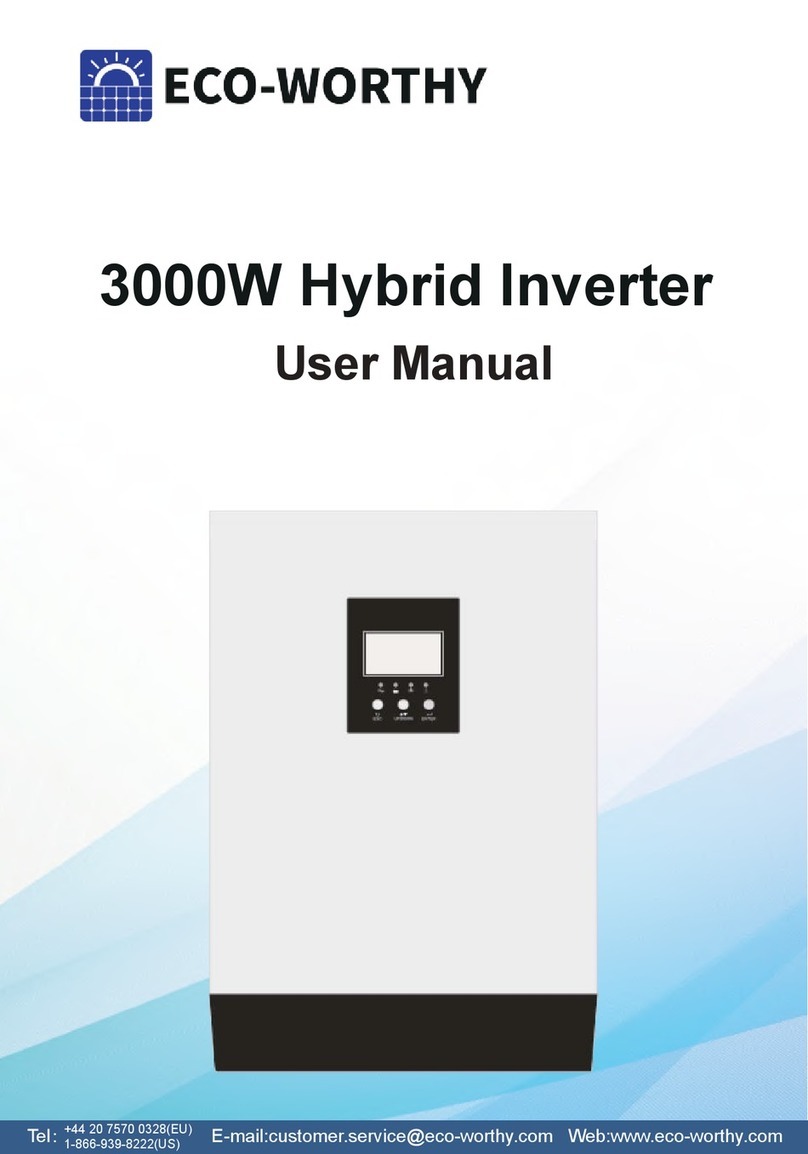
ECO-WORTHY
ECO-WORTHY GA1012P user manual
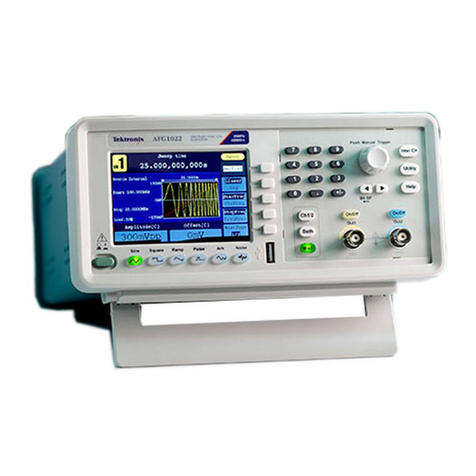
Tektronix
Tektronix AFG1000 Series instructions

Oilon
Oilon ECO Inverter+ 7 Installation and commissioning
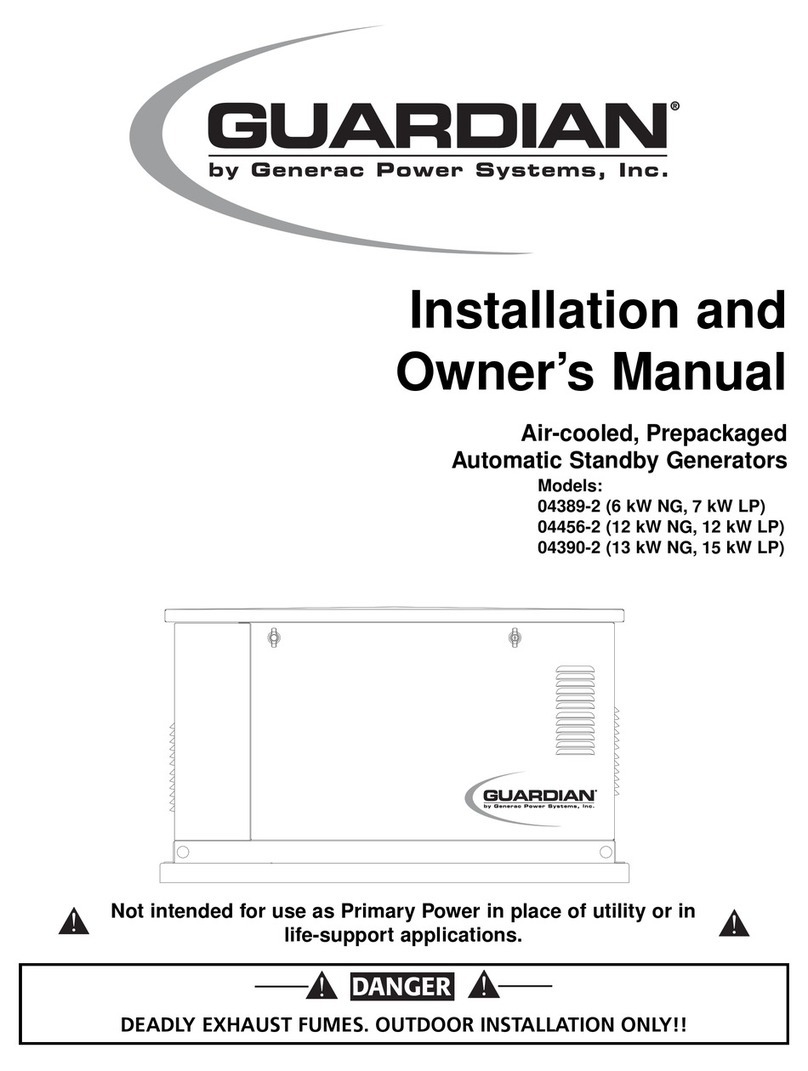
Generac Power Systems
Generac Power Systems Guardian 04389-2 Installation and owner's manual
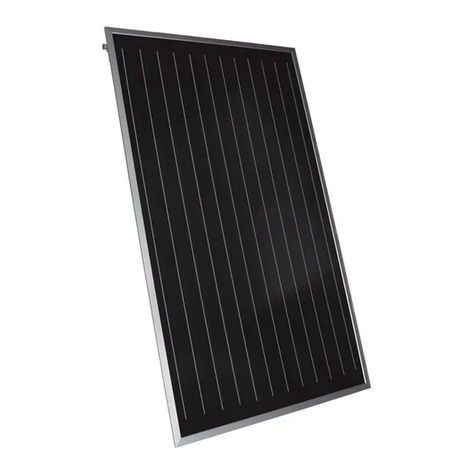
Beretta
Beretta SC-VF25 x 1 instruction manual
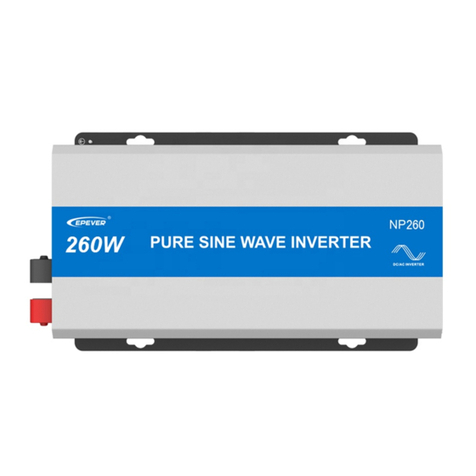
Epever
Epever NPower Series user manual
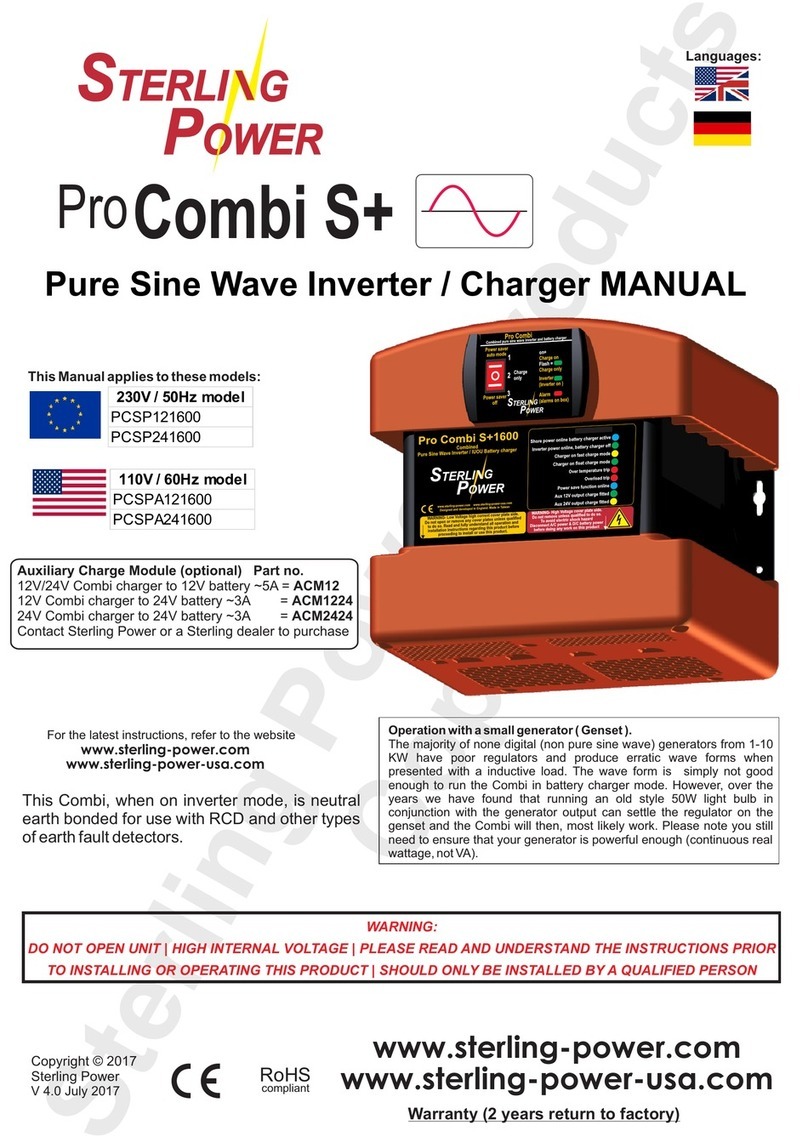
Sterling Power
Sterling Power Pro Combi S+ 1600 Series manual
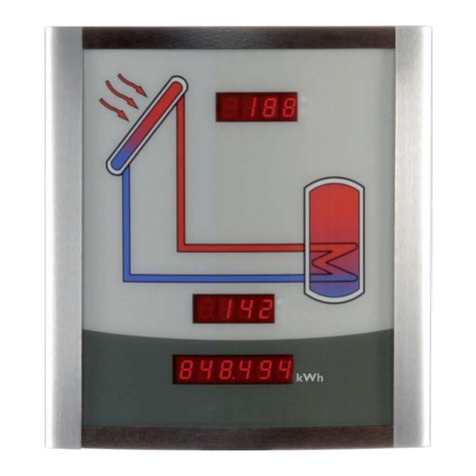
Caleffi solar
Caleffi solar isolar Smart Display SD3 Mounting Connection
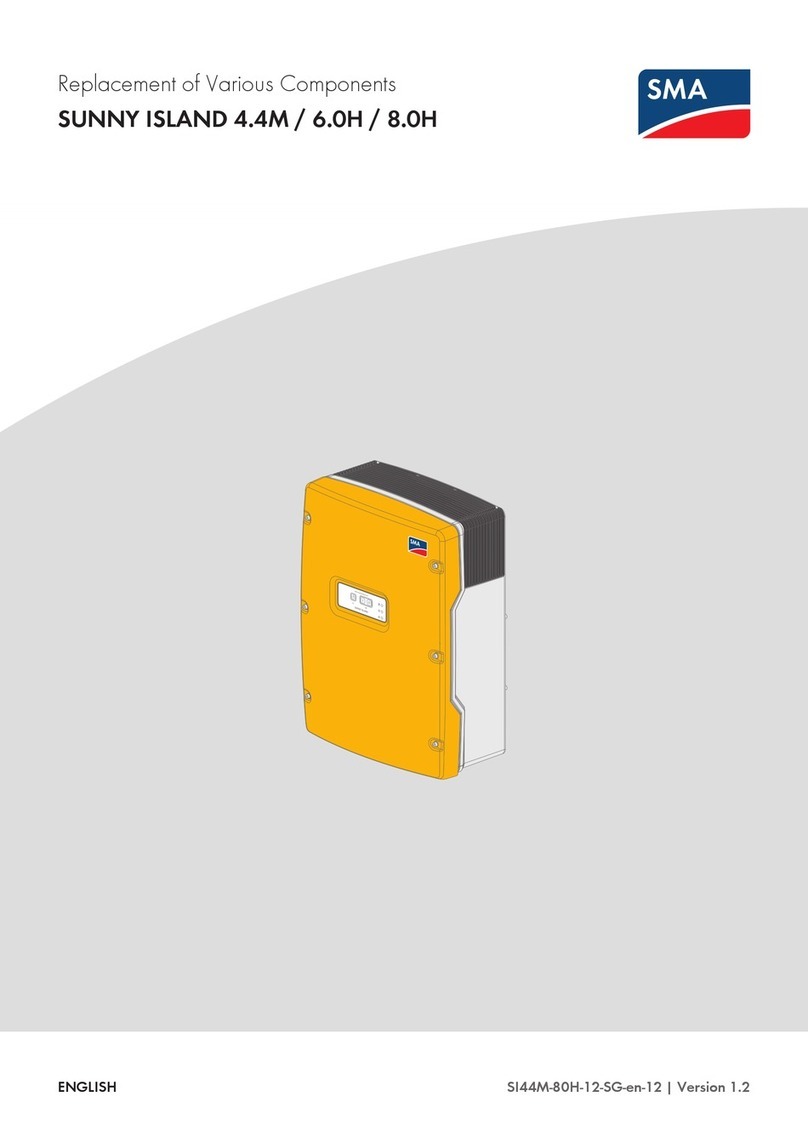
SMA
SMA SUNNY ISLAND 4.4M Replacement of Various Components
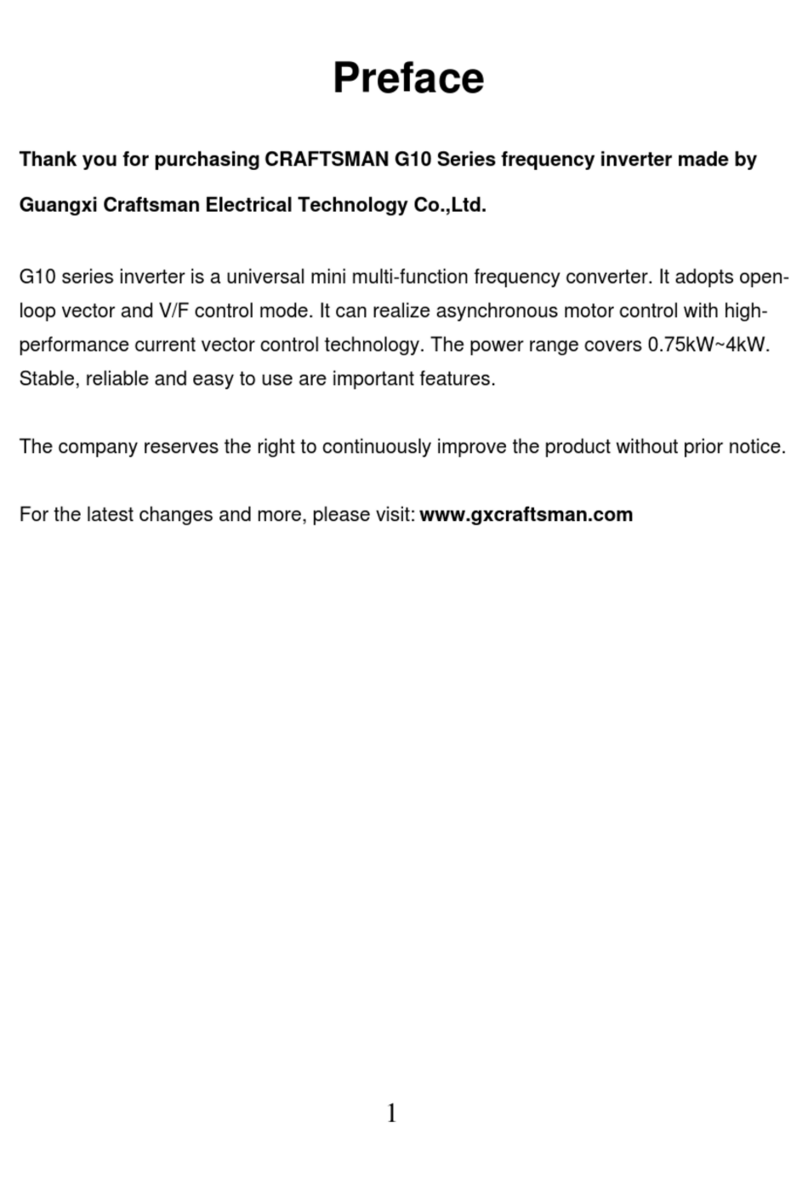
Craftsman
Craftsman G10-0R7G-2SB manual

Votronic
Votronic MobilPOWER SMI 600 Sinus Installation and operating manual

Simmonsigns
Simmonsigns Solar LUA installation guide
